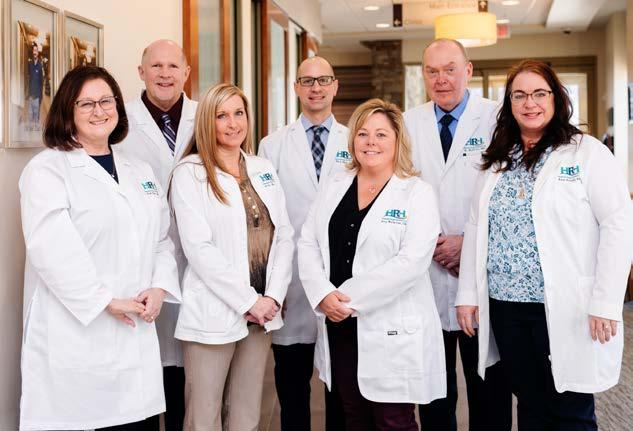
4 minute read
Hawarden’s Best Kept Secret
Hawarden Regional Healthcare is home to a 160-slice CT scanner, the most sophisticated scanner in the Midwest between The Mayo Clinic and Denver.
DISCOVER THE BEST HEALTH CARE CLOSE TO HOME
Advertisement
By Bob Fitch
Hawarden Regional Healthcare wants to get the city’s best kept secret out in the open . Perhaps to the surprise of many, Hawarden Regional Healthcare has the area’s most advanced medical technology, almost without exception .
The days of Hawarden residents needing to drive 20 or 50 miles to undergo the most up-to-date medical procedures are in the past. According to Hawarden Regional Healthcare CEO Jayson Pullman, “People still drive by on their way somewhere else for procedures because they have it in their minds that the Hawarden hospital doesn’t have the latest and greatest technology. We want Hawarden area residents to think of Hawarden first.”
Not only was Hawarden Regional Healthcare (HRH) the first hospital in northwest Iowa to offer 3D mammography on-site, but now it also owns the area’s first 160-slice CT scanner. Computed Tomography (CT) uses special x-ray equipment to obtain images from different angles around the body. A computer processes the images to demonstrate a cross-section of body tissues and organs. CT imaging is useful for visualizing bone, soft tissue, and blood vessels with great clarity.
Kayla Dykstra, HRH radiology manager, said the hospital offers in-house CT scans, mammograms, x-rays, and ultrasound. “We are cutting edge on radiology technology,” she said. Pullman said, “When I first got to Hawarden, we had a 2-slice CT scanner. Then we thought we were advanced when we got a 16-slice scanner; now the facility put in a 160-slice.”
Why is a 160-slice CT scanner a big deal? For patients, it’s the difference between holding your breath for 30 seconds versus holding it for just eight seconds while a scan is done. For someone who may already have health issues or has anxiety about the procedure, “That’s a long 30 seconds,” Dykstra said. “The shorter breath hold is huge. Some people can’t hold their breath that long which then creates motion which creates an unfavorable diagnostic exam. The comfort factor for patients is much higher now.”
Higher slice capabilities increase the diagnostic capabilities of the scanner, resulting in clearer images and lower doses of radiation.
The latest CT scans and 3D mammograms also provide faster results and patients spend less time wondering ‘What’s going on?’ “Many of our patients are getting sameday results without leaving town,” Dykstra said.
She continued, “Back in the day, the provider said, ‘You’re going to go there to get this procedure.’ Now patients are learning they can make the decision where to have a procedure done. You can stay home.” More specialty doctors from Sioux Falls or Sioux City are also discovering they can refer their Hawarden area patients to HRH for procedures.
When Hawarden residents utilize services such as radiology or physical medicine at HRH more often, it also has the effect of HRH being able to invest even more into equipment and personnel, further enhancing local service, Pullman said.
The spinoff effects for the city are significant. The number of jobs HRH provides has gone from 50 to 120 in less than a decade. He emphasized those careers come with excellent pay and benefits.
Hawarden Regional Healthcare’s mantra of “Caring Close to Home” also applies to pandemic-related services. As a partner in the nation’s largest mass vaccination effort since polio, HRH began offering coronavirus vaccinations to the public on Feb. 2nd. It also offers Covid testing.
Naomi Graves, HRH pharmacist, encouraged local residents to register for coronavirus vaccinations at www.hawardenregionalhealthcare.com. Nationwide, the goal is to vaccinate 70 percent of the U.S. population, which puts Hawarden’s target upwards of 1,500 people. Because the vaccine is still in limited supply across the U.S., reaching those vaccination goals are taking longer than hoped. HRH follows priority guidelines from the Iowa Department of Health and the Centers for Disease Control.
Even though a person’s turn in line may not occur right away, Graves encouraged residents to register now so, as availability increases, vaccinations can proceed with all due speed. “There’s a lot of concern about the new variants which are more contagious and will spread more quickly. So we hope to get people vaccinated as quickly as possible,” she said.
Graves explained that the vaccine uses a body’s own cells to create a “protein spike” (think of the classic picture of the coronavirus with all the spikes poking up). A person’s body recognizes the protein spike as foreign and sets up an immune response.
She said it’s normal for people who get the vaccine to show fatigue and possibly fever, arm pain and muscle aches. “This is what you should expect because your body is working hard to make the immune response.”
Graves said HRH is currently using the Moderna vaccine which is a two-dose vaccine spaced about four weeks apart. A person will have his or her fullest immune response about two weeks after receiving the second vaccine dose. While allergic reactions are typically rare, HRH is prepared if a reaction occurs.

Certified Nurse Practitioner Amy Waterman visits with a young patient.
The HRH family practice team. Front: Cindi Rule, ANRP; Jennifer Milby, FNP-C; Amy Waterman, CNP; and Karen Kennedy, ARNP. Back: Kelly Pomerenke, M.D.; Paul Niles, PA-C; and Dale Nystrom, M.D





